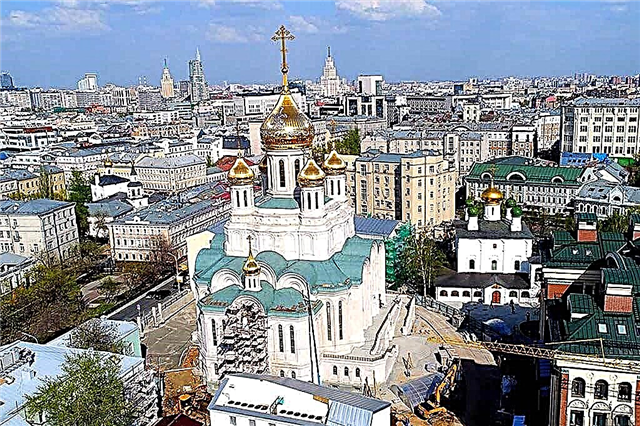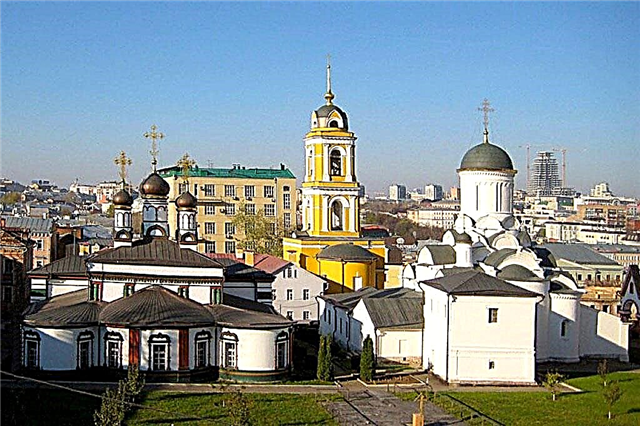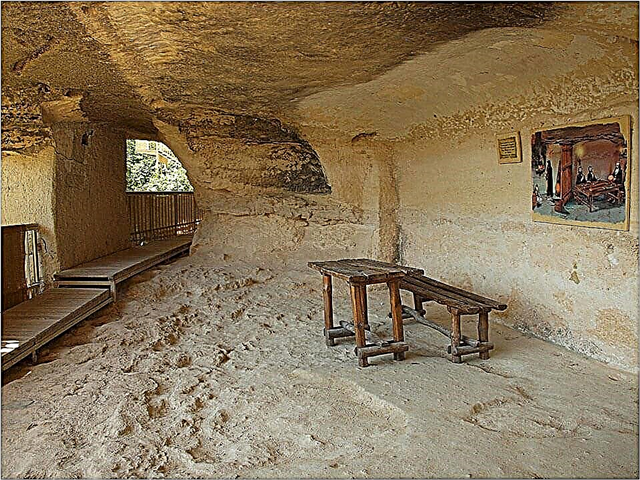There are few quiet places left in the noisy metropolis. These are embankments, green parks, museums and Orthodox monasteries, beyond the walls of which the city bustle does not penetrate. Today, within the borders of Moscow, there are a dozen active monasteries, most of which were founded in the 16th-17th centuries.
Why do they come to monasteries
Believers visit monasteries to venerate the relics of Orthodox saints, to pray in ancient churches and near ancient icons. Monastic necropolises are of great interest. In the cemeteries of the Novodevichy, Donskoy and Novospassky monasteries, not only church hierarchs are buried, but also representatives of eminent noble families, famous writers, artists, singers and politicians.
In addition, many monuments of church architecture have been preserved in Moscow monasteries, which are of great interest to connoisseurs of Russian architecture. These are picturesque temples of the 16th-19th centuries, in the construction of which talented Russian and foreign architects took part.
Novodevichy Convent

View of the Novodevichy Convent from the opposite side of the Novodevichy Pond
One of the most beautiful cloisters of the city has an unusual status. It belongs to the Historical Museum and at the same time is a functioning nunnery. The Novodevichy Convent was founded in the first half of the 16th century and for a long time served as a place of imprisonment for disgraced princesses and tsarins.
The picturesque monastery ensemble adorns the bend of the Moskva River. It is considered an example of Moscow Baroque and has been included in the UNESCO World Heritage List since 2004.
Holy Danilov Monastery

St. Danilov Monastery from a bird's eye view
The men's abode on the right bank of the Moskva River is located 4.5 km south of the Moscow Kremlin. This is the oldest monastery in the city. It appeared in the 80s of the XIII century, thanks to the son of Alexander Nevsky - Prince Daniel.
Under Soviet rule, the monastery was liquidated, and its territory was used for a children's colony. Today the architectural ensemble has been completely restored and is open to pilgrims and tourists.
Donskoy monastery

Great Cathedral of the Don Mother of God
The men's abode appeared at the end of the 16th century, after the defenders of Moscow miraculously managed to repel the attack of the Crimean Khan Gaza II Girey. According to legend, the monastery was dedicated to the Donskoy Icon of the Mother of God, which Prince Dmitry Donskoy took with him to the Kulikovo field. The stone walls became part of a powerful defensive complex and supplemented the fortifications of St. Danilov and Novospassky monasteries that defended Moscow from the south.
The surviving monastery ensemble was formed in the 16th-18th centuries. It consists of several cathedrals, churches, fraternal buildings and a high bell tower, erected in the best traditions of the Elizabethan Baroque.
Novospassky monastery

View of the southeastern tower and domes of the Transfiguration Cathedral
The ancient men's monastery has long served as the family burial vault of the Zakharyin-Romanov boyars, who became the progenitors of the Russian royal dynasty. In addition, on the territory of the monastery, in the majestic Znamensky Church, the counts of the Sheremetyevs, the princes of the Kurakins and representatives of the princely family of the Lobanov-Rostovsky are buried.
The beautiful monastery complex rises on Krutitsky Hill, on the left bank of the Moscow River. Among the temples standing here, the huge Transfiguration Cathedral and the slender bell tower 78 m high stand out.
Nikolo-Perervinsky monastery

Bird's-eye view of Nikolo-Perervinsky monastery
In the southeastern part of the city, there is an old men's Nikolo-Perervinsky monastery. Its existence has been known since the 20s of the 17th century. Students of the Perervinsky Seminary studied here, and during a trip to Crimea, Empress Catherine II made a stopover. According to legend, there was an underground passage in the monastery, which led from the monastery to the Church of the Kazan Mother of God, located on the territory of the royal estate Kolomenskoye.
Sretensky monastery

View of the Cathedral of the New Martyrs and Confessors of the Russian Church on Blood (center) and the Cathedral of the Vladimir Icon of the Presentation of the Mother of God (right) of the Sretensky Monastery
A male monastery appeared in the city center at the end of the 14th century and was built in honor of the salvation of Moscow from the troops of Tamerlane. It played an important role in the spiritual life of the city and was the center of the crowded processions of the cross. The inhabitants of the city, grand dukes, kings and hierarchs of the church took part in them.
During the Time of Troubles, when the Polish-Lithuanian troops ruled in the Moscow Kremlin, the Sretensky Monastery sheltered Russian militias. Today the monastery has been restored, and the monastery choir is considered the main choir of the Russian Orthodox Church.
Conception monastery

Cathedral of the Nativity of the Blessed Virgin Mary of the Conception Monastery
The women's monastery in the Moscow district of Khamovniki appeared in the 1360s. According to legend, Juliana and Eupraxia, the sisters of Metropolitan Alexy, became her first nuns.
Under Soviet rule, nuns and novices were expelled from the monastery, and a prison and a colony for minors were opened in the monastery buildings. The restoration of the dilapidated shrine began in 1991. Today, the architectural ensemble of the monastery includes four above-ground churches and an underground temple of the Assumption.
Vysoko-Petrovsky Monastery

Cathedral of Peter, Metropolitan of Moscow Vysoko-Petrovsky Monastery
A small men's monastery in the very center of Moscow is located next to Petrovka Street. It was created in 1315 and at that time was located outside the city boundaries - in the village of Vysokoe.
For 500 years (2018) in the center of the monastery there has been a unique stone cathedral of Metropolitan Peter, built by the famous Italian architect Aleviz the New. This unusual eight-leafed temple is rightfully considered a real adornment of the picturesque monastery ensemble.
Martha and Mary Convent

Cathedral of the Intercession of the Blessed Virgin Mary of the Martha-Mariinsky Convent
One of the youngest Moscow monasteries appeared at the beginning of the last century, thanks to the Grand Duchess Elizabeth Feodorovna. After her husband died at the hands of a terrorist, the Grand Duchess left secular life and retired to a new monastery.
Today the sisters who live here help in hospitals and hospitals. An orphanage for girls has been opened in the monastery, a patronage service and a canteen where the poor are fed.
Andreevsky Monastery

General view of St. Andrew's Monastery
At the foot of the Sparrow Hills, for several centuries there has been a male monastery, the main temple of which is dedicated to St. Andrew Stratilat. In 1652, a school appeared at the monastery, which became the first academic educational institution in Moscow. Tourists come here to see the 17th century church decorated with colored glazed peacock-eye tiles.
Pokrovsky monastery

View of the main entrance and cathedrals of the Intercession Monastery
The Intercession for Women is the most visited monastery in the city. On weekdays, about three thousand pilgrims come to it, and on weekends and holidays, their number increases to 25-50 thousand people.
Believers go to the monastery to venerate the relics of St. Matrona, who is considered one of the most revered saints in Moscow. In addition, the monastery houses several old icons and relics.
Zaikonospassky monastery

View of the Cathedral of the Image of the Savior Not Made by Hands and the bell tower of the Zaikonospassky Monastery
Not far from the metro station "Ploschad Revolyutsii" there is a men's monastery, which went down in history as a "teacher's monastery". It was founded during the reign of Boris Godunov and got its name because it stood behind the iconic row.
Under the monk and theologian Simeon of Polotsk, a school for clerks was opened in the monastery, which later grew into the Slavic-Greek-Latin Academy.In 1814, the Academy was transferred to Sergiev Posad, and the Theological School continued its work within the walls of the monastery.
Theotokos-Rozhdestvensky monastery

View of the cathedrals of the Nativity of the Monastery
One of the oldest Moscow monasteries is open to tourists and pilgrims on Rozhdestvenka Street. The women's monastery appeared in the city in the 80s of the XIV century and was originally located in the Moscow Kremlin.
The oldest monastery church, the Nativity Cathedral, was built at the beginning of the 16th century and is a fine example of early Moscow architecture. The slender pyramidal church is crowned with a helmet-shaped head and decorated with rows of neat keeled zakomars. Today, the monastery has a three-year singing school, where women get acquainted with the catechism and liturgy, master solfeggio and learn church singing.
John the Baptist Monastery

View of the Cathedral of the Beheading of John the Baptist and the bell tower of the John the Baptist Monastery
Near the metro station "Kitay-Gorod" there is a convent, founded in the 15th century. In 1812, when Napoleon's troops entered the city, the monastery was in a zone of severe fires and burned to the ground. Only in the 1860-1870s, the lost churches and buildings were rebuilt. The beautiful monastery ensemble in the neo-Renaissance style appeared thanks to the talented architect Mikhail Dormedontovich Bykovsky.
Alekseevsky monastery

View of the Church of All Saints of the Alekseevsky Monastery
The women's monastery was founded in the middle of the XIV century, but she moved to Krasnoe Selo in 1837. By the beginning of the last century, more than forty workshops and four churches existed on the territory of the monastery. In 1926, almost all of the monastery buildings were demolished, and a road was built on the vacated territory. The restoration of the monastery began in 1991, creating a parish at the preserved Church of All Saints.











